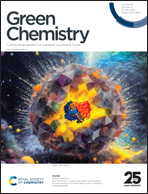Bioderived silicon nano-quills: synthesis, structure and performance in lithium-ion battery anodes†
Abstract
Cellulose nanocrystals (CNCs) are bioderived one-dimensional species with versatile surface chemistry and unique self-assembling behavior in aqueous solutions. This work presents a scientific approach to leverage these characteristics for creating CNC network templates and processing them to engineer a novel silicon (Si)-based material called silicon nano-quill (SiNQ) for energy storage applications. The SiNQ structure possesses a porous, tubular morphology with a substantial ability to store lithium ions while maintaining its structural integrity. The presence of Si suboxides in the SiNQ structure is demonstrated to be crucial for realizing a stable cycling performance. One of the defining attributes of SiNQ is its water dispersibility due to Si–H surface bonds, promoting water-based Si-graphite electrode manufacturing with environmental and economic benefits. The incorporation of only 17 wt% SiNQ enhances the capacity of graphitic anodes by ∼2.5 times. An initial coulombic efficiency of 97.5% is achieved by employing a versatile pre-lithiation. The SiNQ-graphite anodes with high active loading, when subjected to accelerated charging/discharging conditions at 5.4 mA cm−2, exhibit stable cycling stability up to 500 cycles and average coulombic efficiency of >99%. A generalized physics-based cyclic voltammetry model is presented to explain the remarkable behavior of SiNQs under fast-charging conditions.



 Please wait while we load your content...
Please wait while we load your content...